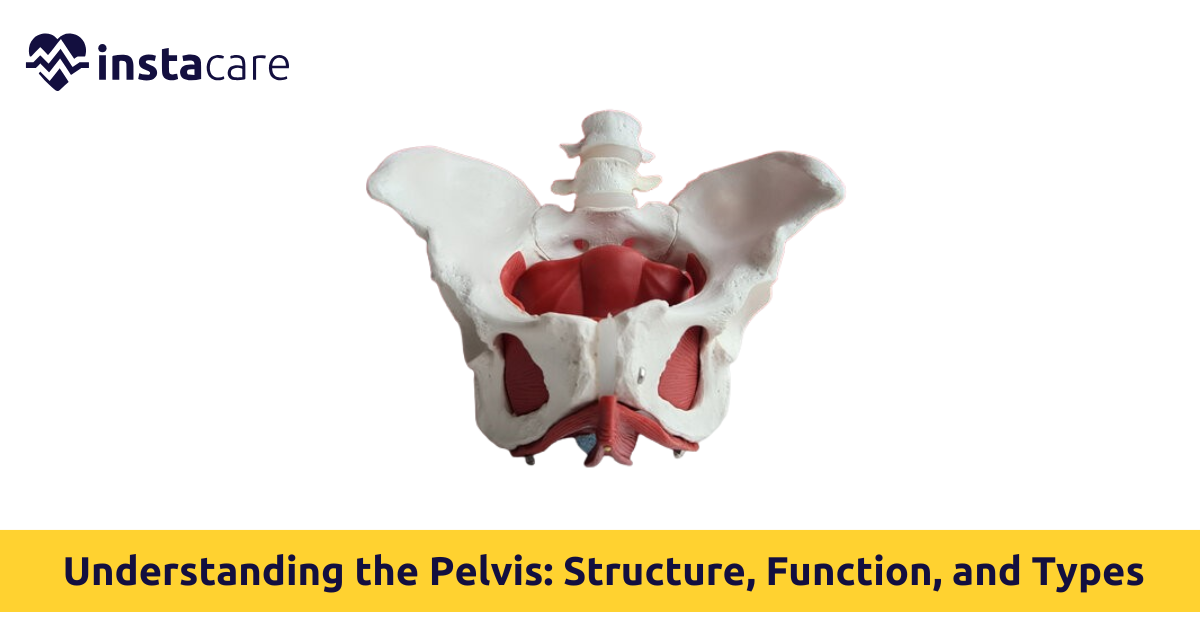The pelvis is a crucial component of the body's anatomy that runs from spine and legs and contains numerous fundamental organs. It is of greatest significance to posture, allowing movement, supporting weight, and protecting sensitive internal processes. Baring the pelvis, shape, forms, and accompanying illness, we may better appreciate how critical this region is to our daily functioning and to our overall health.
What is the Pelvis?
Pelvis is an organized bone of lower part between thighs and abdomen. Pelvis is the foundation of the backbone, and it has the socket of hip joint which contains the unity of upper and lower body structures.
Anatomically, there is a Lower abdomen and pelvis connection and the pelvis is made up of two hip bones (each being the ilium, ischium, and pubis), the sacrum, and the coccyx. They all create a rigid ring as one grows older, providing structural support to the lower torso.
Male pelvis and female pelvis not only vary in size but also in shape. Male pelvis is stronger and wider than female pelvis, which is shallow but wide to accommodate the process of giving birth.
Different Types of Pelvis
Pelvis types tend to be divided according to the shape of the inlet of the pelvis, the passage through which a baby exits. Knowledge of types, particularly in obstetrics, is critical since it influences labor and delivery.
- Gynecoid pelvis: Gynecoid pelvis is the most frequent female pelvis and best suited to deliver since it is round with larger dimensions.
- Android pelvis: Android pelvis, which is frequent in men, is heart-shaped and therefore not best suited for vaginal delivery.
- Anthropoid pelvis: The anthropoid pelvis is egg-shaped and longer from back to front than from side to side.
- Platypelloid pelvis: Lastly, the platypelloid pelvis is flat and wide but not deep and therefore not best suited during labor.
All pelves have clinical relevance and represent the mechanism of labor and susceptibility to some forms of pelvic condition or injury.
What is Structure of Pelvis?
Structure of pelvis is multifunctional and complex and involves bones, ligaments, joints, muscles, and organs that are interrelated in such a manner as to give the physical function and covering for internal machinery.
- Bones: Pelvis structure comprises the bones that constitute its base which are fixed firmly at important points such as sacroiliac joints and pubic symphysis. Pelvic bones are supported by firm ligaments to provide the pelvis with hardness as a structure and permit minimal movement required to produce stability and pliability.
- Pelvic floor muscles: Beneath this suspensory bone framework is a musculature framework known as the pelvic floor muscles. These muscles constitute a sling that suspends organs such as the bladder, uterus (female), and rectum. They are made to provide continence of urine and stools, coitus, and parturition (childbirth).
- Organs: The pelvic cavity, and the bones and musculature that contain it, contains some very significant organs. In the male body, it contains the bladder, prostate, and intestines. In the female body, it contains the vagina, ovaries, fallopian tubes, and uterus, along with the bladder and rectum. Blood vessels, lymph nodes, and nerves pass through the pelvis so that the pelvis can be considered a center of body life activities.
Learn About Common Functions of Pelvis
The pelvis also carries out a variety of functions common to everyday life. The first is structural, support of the spine and load transfer from the top of the body to the bottom of the body. It is therefore vital to balance, posture, and movement.
- The pelvis also has space for movement. It serves as a running, walking, and bending pivot point, and joints and muscles are provided with enough space to move.
- Its second main role is protection. The pelvis protects and encapsulates internal organs from damage or destruction. This is especially realized in accidents, where the skeleton encapsulates inner systems from devastation.
- The female pelvis also has a primary function in reproduction. It holds a fetus during pregnancy and is the birth canal when a woman gives birth. Its elasticity and shape are ideally suited to these functions.
- Lastly, pelvic floor muscles have the important role of bladder and bowel control, prevention of loss of continence, and preservation of sexual function.
Pelvic Health and Common Disorders
Pelvic health is a critically important part of health but one that crosses the mind only when something goes wrong. Anatomical pathology of pelvic organs can vary from trivial nuisance to full-blown medical emergencies.
- Pelvic Pain: The most frequent symptom is pelvic pain, which can be muscular, bony, or intrinsic visceral in nature. It can be secondary to menses in women, endometriosis, or PID. In men, it can be secondary to prostatitis.
- Pelvic fractures: Pelvic fractures are high-energy trauma injury such as fall or motor vehicle crash. They are emergent disease and can be diagnosed by pelvis x-ray or pelvic ultrasound. They are treated from severity to immobilization, analgesia, or surgery.
- Pelvic inflammation: Pelvic inflammation, which is typically secondary to infection, may be of reproductive or urinary tract. PID is a female cause of infertility if left untreated.
- Pelvic floor dysfunction: Pelvic floor dysfunction is not a rare occurrence, particularly in women after child birth or otherwise at any age. Contraction or relaxation of pelvic floor muscles can lead to incontinence of urine, constipation, or organ prolapse. Exercise therapy, physiotherapy, or surgical rehabilitation is provided as a management.
Identification of these centers and markers will lead to early diagnosis and treatment and better outcome and quality of life.
What Is Clinical Examination of Pelvis?
Proper clinical examination of pelvis is most crucial to identify injury, infection, or any structural defect. Initial impression by physicians in the form of visual inspection is generally done with posture, swelling, bruising, or asymmetry inspection. Palpation assists to verify tenderness, deformity, or bone location.
For the removal of internal trauma, imaging studies such as pelvic ultrasound or x-ray pelvis are typically used. X-rays are optimal in the case of bone fracture or joint dislocation diagnosis and ultrasonography is useful in imaging of soft tissue structure and organs.
For some of the instances, women who present with symptoms of discharge, bleeding, or pain are subjected to an internal pelvic exam. This is accomplished by manually checking for the vaginal wall, cervix, or the uterus for masses, swelling, or irregularities. For complicated cases or severe condition, additional tests such as MRI and CT scans are performed in a bid to better visualize the Pelvic region anatomy.
Conclusion
Pelvis is exquisitely designed piece of construction which performs a tremendous amount of ancient functions, between support and motion, from safety to reproduction. Pelvis's top-down ordering of space within the bones, muscles, and organs makes pelvis central with respect to most measures of human health. Anatomical knowledge and classifying the pelvis, symptoms and signs awareness of repeated occurring common disease such as pelvic inflammation or pelvic pain, and routine check-up appointments can indeed promote pelvis wellness.
Please book an appointment with the
Best Gynecologist in Lahore, Karachi, Islamabad, and all major cities of Pakistan through
InstaCare, or call our helpline at 03171777509 to find a verified doctor for your disease.

